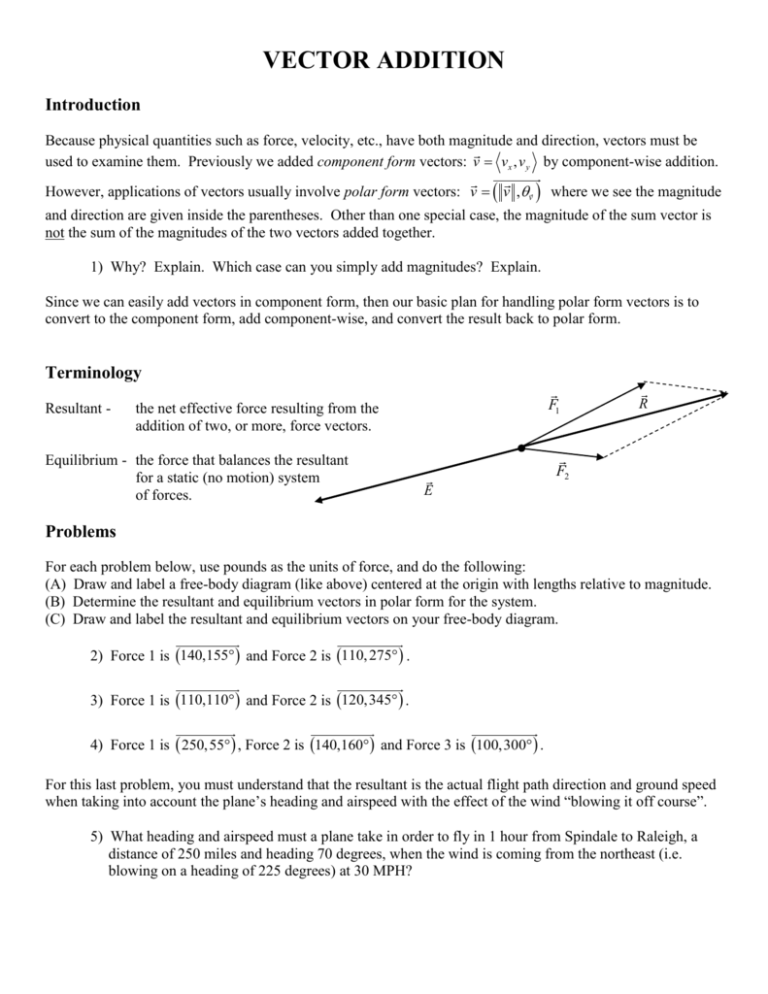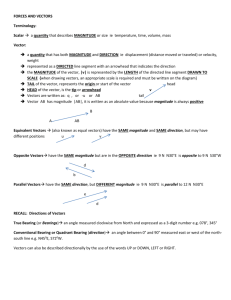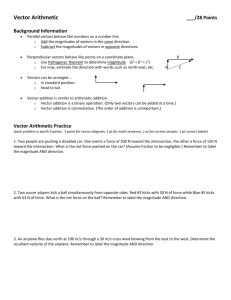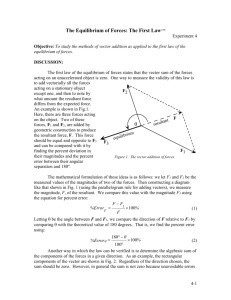VECTOR ADDITION - Labs for Pre
advertisement

VECTOR ADDITION Introduction Because physical quantities such as force, velocity, etc., have both magnitude and direction, vectors must be used to examine them. Previously we added component form vectors: v vx , v y by component-wise addition. However, applications of vectors usually involve polar form vectors: v v ,v where we see the magnitude and direction are given inside the parentheses. Other than one special case, the magnitude of the sum vector is not the sum of the magnitudes of the two vectors added together. 1) Why? Explain. Which case can you simply add magnitudes? Explain. Since we can easily add vectors in component form, then our basic plan for handling polar form vectors is to convert to the component form, add component-wise, and convert the result back to polar form. Terminology Resultant - F1 the net effective force resulting from the addition of two, or more, force vectors. Equilibrium - the force that balances the resultant for a static (no motion) system of forces. R F2 E Problems For each problem below, use pounds as the units of force, and do the following: (A) Draw and label a free-body diagram (like above) centered at the origin with lengths relative to magnitude. (B) Determine the resultant and equilibrium vectors in polar form for the system. (C) Draw and label the resultant and equilibrium vectors on your free-body diagram. 2) Force 1 is 140,155 and Force 2 is 110, 275 . 3) Force 1 is 110,110 and Force 2 is 120,345 . 4) Force 1 is 250,55 , Force 2 is 140,160 and Force 3 is 100,300 . For this last problem, you must understand that the resultant is the actual flight path direction and ground speed when taking into account the plane’s heading and airspeed with the effect of the wind “blowing it off course”. 5) What heading and airspeed must a plane take in order to fly in 1 hour from Spindale to Raleigh, a distance of 250 miles and heading 70 degrees, when the wind is coming from the northeast (i.e. blowing on a heading of 225 degrees) at 30 MPH? Solutions 1) Since “the shortest distance between two points is a straight line” then two nonparallel vectors in a tip-to-tail fashion will form the “long way around” while the resulting sum vector will be the shorter “direct route”. Thus, the magnitude of the resulting sum vector is less than the sum of the magnitudes of the two vectors. On the other hand, if the two vectors are parallel, then the tip-to-tail method shows the two vectors form a line. Thus, the resulting sum vector and the two vectors follow the same path between start and end points making the magnitude of the resulting sum vector equal to the sum of the magnitudes. 2) Rx 140cos155 110cos 275 117.3 Ry 140sin155 110sin 275 50.4 R 117.3 50.4 2 2 127.7 50.4 R arctan 117.3 180 203.3 R 127.7, 203.3 3) E 127.7, 23.3 Rx 110cos110 120cos345 78.3 Ry 110sin110 120sin 345 72.3 78.3 72.3 106.6 R arctan 72.3 78.3 0 42.7 R 106.6, 42.7 R 4) 2 2 E 106.6, 222.7 Rx 250cos55 140cos160 100cos300 61.8 Ry 250sin 55 140sin160 100sin 300 166.1 61.8 166.1 177.2 R arctan 166.1 61.8 0 69.6 R 177.2,69.6 R 5) 2 2 E 177.2, 249.6 Convert headings to trig angles and airspeed to magnitude as shown in diagram with P W R . Then we have: Px 30cos 225 250cos 20 Px 250cos 20 30cos 225 256.1 Py 30sin 225 250sin 20 Plane pointing P ?? Ral Py 250sin 20 30sin 225 106.7 256.1 106.7 277.4 P arctan 106.7 256.1 0 22.6 P 277.4, 22.6 P 2 2 Spi Wind Convert back to headings and airspeed. The plane must fly at about 277 MPH on heading about 67 degrees. Resulting path W 30, 225 R 250, 20







